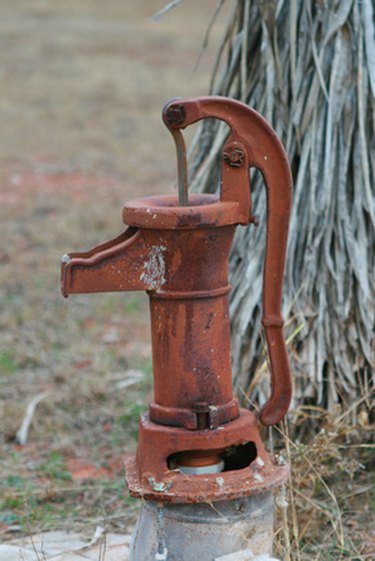Things You'll Need
Cistern
Water source

A cistern is a water storage tank buried in the ground, under houses or above ground. Older cisterns are usually made of materials such as cement, wood or metal. Outdoor, open-top cisterns capture rainwater while closed cisterns receive water from drains or pipes bringing water from other sources. A third option to fill a cistern is to haul water to the tank from water hauling trucks. Water from a cistern is not safe for drinking unless chemically treated, according to the Missouri Department of Health and Senior Services. Uses for cistern water include showering, household cleaning, irrigating gardens and landscaping.
Step 1
Clean an old water cistern before refilling with water. Wash the inside walls and bottom with “1/4 cup of 5.25 percent liquid chlorine bleach in 10 gallons of water” suggests University of Florida IFAS Extension. Remove any sediment collected on the bottom of the tank.
Video of the Day
Step 2
Seal the cistern if there are any cracks. Cisterns should be watertight. If the tank’s material is cement, use a cement sealant. Cracks in cisterns allow possible contaminants to leak into the water.
Step 3
Attach a pump or other water retrieval source. If the cistern is underground or on-ground, a pump is necessary to retrieve the water. If the cistern is elevated, attach a valve to the bottom of the tank using pressure to reclaim the water.
Step 4
Set up water pipes from the water source or guttering downspouts from the roof to allow water to enter the cistern. If you use guttering to direct the water into the cistern, place wire mesh over the downspout’s opening to help keep leaves and other debris from entering the tank.
Step 5
Install an overflow pipe for excess water runoff or cover the tank when full. An overflow pipe allows you to control excess water by aiming runoff to other locations away from the tank.
Step 6
Connect the cistern to the house piping if you are going to use your cistern for household uses. Many people depend on water holding tanks and cisterns for daily water needs. Cisterns use the same method as other water sources to pipe the water into houses.
Video of the Day